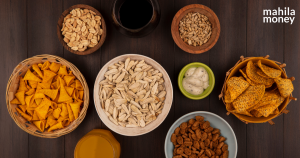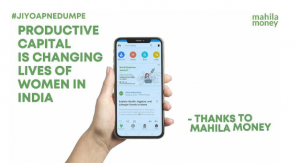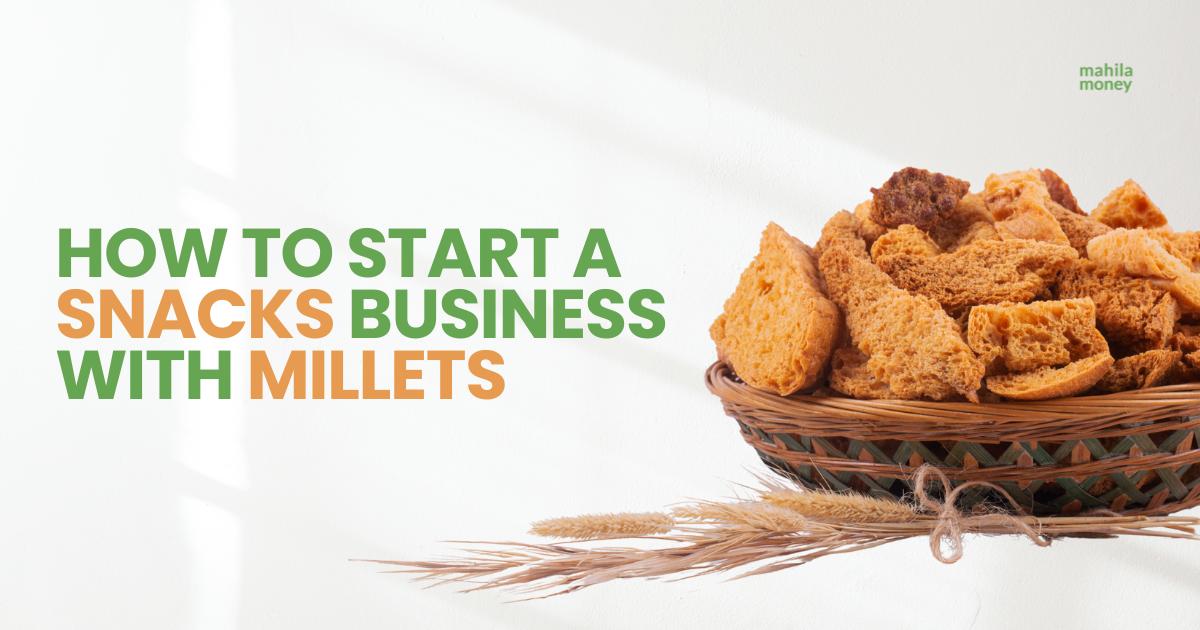Looking for some small-scale food business ideas? The Indian appetite for nutritious nibbles is soaring. The healthy snacks business touched USD 3.9 billion in 2024 and is projected to cross USD 6 billion by 2030, growing at about 7‑8 per cent a year. Alongside this momentum, 2023, the United Nations’ International Year of Millets has pushed the grain back onto supermarket shelves and family plates alike. For women looking to turn family recipes into a profitable food business in India, starting a healthy snacks business can be a great first step.
This guide walks you through every stage of turning your idea into a real‑world venture, from researching the market to clearing compliance. Read it once, bookmark what matters, and come back whenever you need the next nudge forward.
1 | Why Start A Millet Snacks Business
Millet based food business ticks three crucial boxes for modern consumers: nutrition, convenience, and an authentic Indian back‑story. Naturally gluten-free and rich in fibre and micronutrients, they meet the rising demand for superfoods that support weight management, blood sugar regulation, and digestive health, making them a perfect healthy snacks business idea. Environmentally, millets grow in arid soils with minimal water; selling them allows you to discuss sustainability without greenwashing. Add the government’s millet promotion drives, from agri‑tech incubators to recipe contests, and you have a marketing tailwind that costs you nothing.

2 | Meet the Grain Family You’ll Be Working With
Finger millet (ragi) brings calcium; pearl millet (bajra) adds iron; sorghum (jowar) gives a neutral flavour that adapts to both savoury and sweet profiles, while foxtail, little, and kodo millets lend crisp textures to baked snacks. Buying directly from Farmer-Producer Organisations or local mandis not only lowers costs but also helps you tell a “farm‑to‑table” story that urban buyers love, especially parents searching for millet snacks for their kids.
3 | Designing Your First Product Line
For starting a healthy snacks business, start small. Two or three core items are easier to perfect, package, and promote than a confusing menu for this low investment snack business. A popular trio is a ragi cookie for lunchboxes, a bajra or foxtail khakhra for office tiffins, and a lightly spiced jowar puff that competes with conventional chips. Each product showcases a different millet and targets a slightly different customer, widening your reach without stretching your capacity. Resist the urge to copy‑paste recipes from the internet; spend a fortnight tweaking sweetness, spice, or crunch until family and friends ask for refills without you offering.
4 | Understanding Your Market and Pricing Smartly
Before ordering labels for your healthy snacks business, spend a week mapping the snack landscape around you. Visit local organic stores, scroll through #milletsnacks and #lowinvestmentsnackbusiness hashtags on Instagram, and join neighbourhood WhatsApp food groups. Notice price bands: home‑grown ragi cookies selling at ₹150-₹200 for 250 g, artisanal khakhras at ₹70-₹90 a piece, premium granola bars nudging ₹40 a piece. Your goal is to position slightly above mass grocery brands yet below high‑end gourmet stores, allowing a healthy margin without scaring first‑time buyers.
Your 7-Step Blueprint to Launch a Healthy Snacks Business
Step 1: Plan and Research. Begin with a one‑page business note: target customer, two main products, estimated selling price, daily sales goal, and break‑even timeline. This clarity keeps you from getting lost in Pinterest boards and packaging catalogues and sets you up for a millet‑based food business that can scale.
Step 2: Perfect the Recipes. Treat recipe development like R&D. Draft a cost sheet that lists raw grains, spices, sweeteners, oven time, electricity, and labour. Aim for a cost‑of‑goods‑sold (COGS) that is 50-60 per cent of your intended retail price; the remaining 40-50 per cent covers packaging, marketing, and profit. Conduct a two-week shelf-life test by storing samples at room temperature and monitoring texture, taste, and moisture, laying the essential groundwork for any future millet processing business expansion.
Step 3: Build a Home Production Zone. A small OTG oven, a sturdy mixer-grinder, stainless-steel prep tables, airtight grain bins, a digital weighing scale, and a heat sealer are usually enough to get started with your healthy snacks business for the first three months. This is a low investment snack business model that you can grow at your own pace.
Step 4: Create a Brand That Feels Trustworthy. Choose a name that hints at both health and tradition, such as “GrainGlow” or “DesiBowl.” Use earthy colours on kraft‑paper pouches, add a small transparent window so the product sells itself, and print straightforward labels: ingredient list, manufacturing date, net weight, and “Best Before” date.
Step 5: Price for Profit, Not Just Popularity. If a 100 g pack costs you ₹18 to produce and package, selling below ₹36 leaves little to reinvest. Launch offers are fine, but calculate them into your margin; a “buy‑two‑get‑one‑free” effectively slashes revenue by 33 percent – make sure volume gains cover it.
Step 6: Select Sales Channels and Market Relentlessly. Open a free WhatsApp Business catalogue, then film 15‑second reels showing the day’s bake cooling on wire racks; authenticity trumps slick ads. Listing on Amazon’s “Saheli,” Flipkart’s “Samarth,” or even Meesho teaches you how to sell homemade snacks online with minimal fees. Offline, approach yoga studios for post‑class snack boxes, and offer resident‑welfare societies a weekend tasting table.
Step 7: Clear Legal and Safety Hurdles. Register for an FSSAI Basic Licence if your healthy snacks business has an annual turnover of under ₹12 lakh; the fee is just ₹100 per year. Should sales cross that mark, upgrade to a State Licence, which ranges from ₹2,000 to ₹5,000 annually. Display your 14‑digit FSSAI number on every pack. A GST registration becomes obligatory only when the revenue exceeds ₹20 lakh. Finally, check with your municipal office for a simple trade licence; many cities process these online for under ₹1,000.
6 | Your First Ninety Days – What Progress Looks Like
Most women report spending the first month perfecting recipes and paperwork, breaking even on equipment in month two, and reaching consistent weekly profit by the end of month three. Success rarely arrives in a straight line, but a clear calendar helps: recipe finalisation in weeks 1-2; licence applications and label printing in weeks 3-4; soft digital launch in month two; and the first pop‑up stall or society fair in month three. By then, you’ll know which SKU moves fastest for your low investment snack business, whether a new flavour is worth testing, and how much stock to bake without waste.
7 | A Real‑Life Inspiration – Manasi Apte’s Millet Journey
When 53‑year‑old Manasi Apte began reworking family meals to suit her and her husband’s medical diets, neighbours took notice of the taste as much as the health benefits. Orders trickled in, then flooded. A ₹ 1.5-lakh Mahila Money loan enabled her to purchase a larger oven, bulk grains, and extra refrigeration. Within four months, her diet‑friendly millet menu, think protein dosa mixes and ragi laddoos, jumped from serving 300 customers to more than 500, adding roughly ₹15,000 to her monthly household income. In her own words: “I never thought I’d be on this incredible journey, making a difference one delicious bite at a time.”
Common FAQ’S: Solving the Small Problems That Stop You from Starting
Starting a millet-based healthy snacks business from home sounds exciting until the real-life hurdles show up. Packing jitters, order chaos, and family expectations, it’s normal to feel stuck. But each of these challenges has a simple, doable solution. Let’s talk about the most common ones.

1. “How Should I Pack My Snacks?”
For many women, packaging feels harder than cooking for a low investment snack business. What if it doesn’t look good? What if people don’t trust homemade snacks?
- Start with resealable kraft paper or stand-up pouches, food-safe and easily available online. Add a clean, printed sticker with your product name, ingredients, date, and FSSAI number (if available).
- Buy a basic heat sealer (₹700–₹1,000) to keep snacks fresh and give your setup a more professional look.
Pro-Tip: Good design helps, but don’t wait for perfect branding to start. Clarity and hygiene matter more.
2. “How Much Should I Make in the Beginning?”
Start too small, and you’re constantly cooking. Too big, and you waste effort and money for a profitable food business in India.
- Begin with 10-15 packs per product for your first test batch.
- Use this batch to test shelf life, taste, and feedback. Launch with a small sampler pack; it’s easier to sell and builds customer trust.
Pro-Tip: Don’t guess. Track what sells and double only what’s working.
3. “How Do I Keep Track of Orders?”
In the early days, it’s easy to lose track of who ordered what, especially when orders come via calls, DMs, or WhatsApp.
- Create a free WhatsApp Business account or share a simple Google Form for orders.
- Decide on an order cut-off time (e.g., 6 PM) to manage your day more effectively.
Pro-Tip: Maintain a small handwritten order notebook; it’s still the most reliable backup.
4. “Who Will Help Me If Things Get Busy?”
You don’t need a big team, but you do need support for your healthy snacks business to flourish.
- Ask family members to pitch in: maybe your daughter handles stickers, your husband delivers orders on Sundays, or your neighbour helps seal packs.
- Set fixed “snack business hours” so you don’t burn out or miss home responsibilities.
Pro-Tip: Make a weekly routine with 2–3 cooking days. Your business should fit your life, not overtake it.
Conclusion -Your Next Step Starts Today
A millet‑based healthy snacks business doesn’t demand a factory or a fortune-only disciplined planning, consistent quality, and a story that resonates with health‑conscious buyers. If you’re ready to turn today’s kitchen experiment into tomorrow’s income stream, take the first practical step now.
Apply for a Mahila Money business loan to fund your oven, packaging, or first promotional campaign, and write your own success story in the booming world of profitable food business in India.
Read More:
How to Start a Candle Making Business from Home in India with Just ₹5,000
How to Start a Jewellery Business Online in India: A Step-by-Step Guide for Women Entrepreneurs
How to Start a Cotton Bag Manufacturing Business in India

If you are a woman entrepreneur who wants to take your business to new heights and is in need of working capital and entrepreneurship resources, come speak to us on Mahila Money. For more such #JiyoApneDumPe live conversations, download the Mahila Money App on Play Store or visit us on www.mahila.money






Mindset + market demand = perfect combo! Ye article padkar kaafi clarity mili. Definitely worth sharing for anyone planning to start something nutritious & home-based 🍪🌱